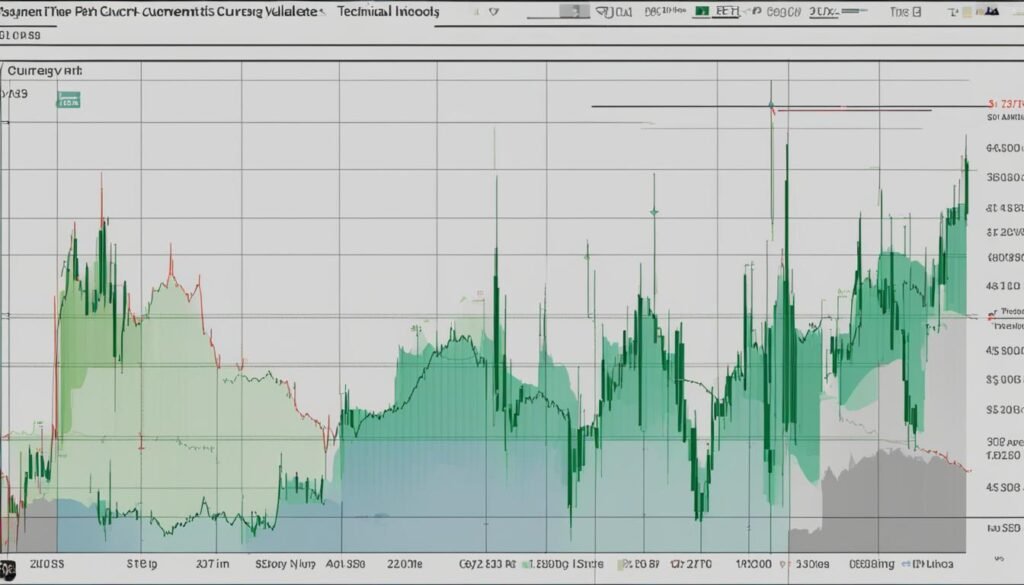If you are new to trading in the currency markets, technical analysis can seem like a daunting subject. However, with the right knowledge and tools, you can use trend analysis to make informed trading decisions. Technical analysis trend analysis involves analyzing market trends to identify patterns in price movements over time.
Buy This Premium Website for Only 18999 CHF!
Acquire a high-authority website complete with content and a premium domain name.
Contact Us Today: Email: info@cleardesign.ch
By understanding market trends, you can gain insights into potential market price movements and make more informed trading decisions. Technical analysis trend analysis is an essential skill for traders in the currency markets, providing valuable insights into key trading decisions.
Unlock the Secret to Forex Success with BOB James’ Top-Performing Signals! Experience the Ease of Proven, MyFXbook-Verified Strategies and Transform Your Trading Journey Today. Don’t Miss Out on Exceptional Performance – Join Now!
Key Takeaways:
- Technical analysis trend analysis helps traders gain insights into market trends and make informed trading decisions.
- By analyzing price movement patterns over time, traders can identify potential market price movements.
- Technical analysis trend analysis is a crucial skill for traders in the currency markets.
- Market trends are essential for understanding market movements and making trading decisions.
- By mastering the basics of technical analysis trend analysis, traders can gain valuable insights to make profitable trading decisions.
Understanding Technical Analysis
Technical analysis is a methodology used in financial markets to forecast future price movements. It involves analyzing charts and market data to identify trends and patterns that can help traders make informed trading decisions.
At its core, technical analysis seeks to understand the psychology of market participants, including buyers and sellers, to determine the direction of a price trend. This is achieved through the use of various technical indicators, including moving averages, oscillators, and chart patterns.
One of the critical aspects of technical analysis is identifying market trends. Understanding whether a market is trending or range-bound can be extremely helpful in determining whether to go long or short on a particular security. Technical analysts use price charts and other technical indicators to identify trends, which can help traders make better-informed decisions.
The Role of Technical Indicators in Understanding Market Trends
Technical indicators are essential tools that traders use to analyze market trends. These indicators track market data, including price, volume, and open interest, and can be used to identify patterns and trends. Some of the commonly used technical indicators include:
| Indicator | Description |
|---|---|
| Moving Averages | Moving averages are used to smooth out price movements and identify trends. |
| Relative Strength Index (RSI) | The RSI measures the strength of a security by comparing its upward and downward price movements |
| Bollinger Bands | Bollinger Bands measure a security’s volatility and help traders identify overbought/oversold conditions. |
| MACD | The MACD measures the difference between a security’s short-term and long-term moving averages and can help traders identify trend reversals. |
Tip: It’s important to note that technical indicators should be used in conjunction with other forms of analysis, such as fundamental analysis, to gain a more comprehensive understanding of the market.
To summarize, technical analysis is a valuable tool for traders that can help them identify market trends and make informed trading decisions. By using technical indicators to analyze market data and identify patterns, traders can gain valuable insight into future price movements and take advantage of profitable trading opportunities.

Fundamental Concepts of Trend Analysis
In the previous section, we explored the basics of technical analysis and the importance of identifying market trends. In this section, we will delve deeper into trend analysis, discussing the fundamental concepts of price patterns, support, and resistance levels.
Price Patterns
Price patterns are a fundamental concept in trend analysis. These patterns establish the market trend, and a trader can use them to forecast future price movements. Price patterns are specific formations of price bars on a chart that represent possible trend continuation or trend reversal.
There are several types of price patterns, including reversal patterns such as head and shoulders and double tops/bottoms, and continuation patterns such as flags and triangles. Recognizing these patterns is essential to successful trend analysis.
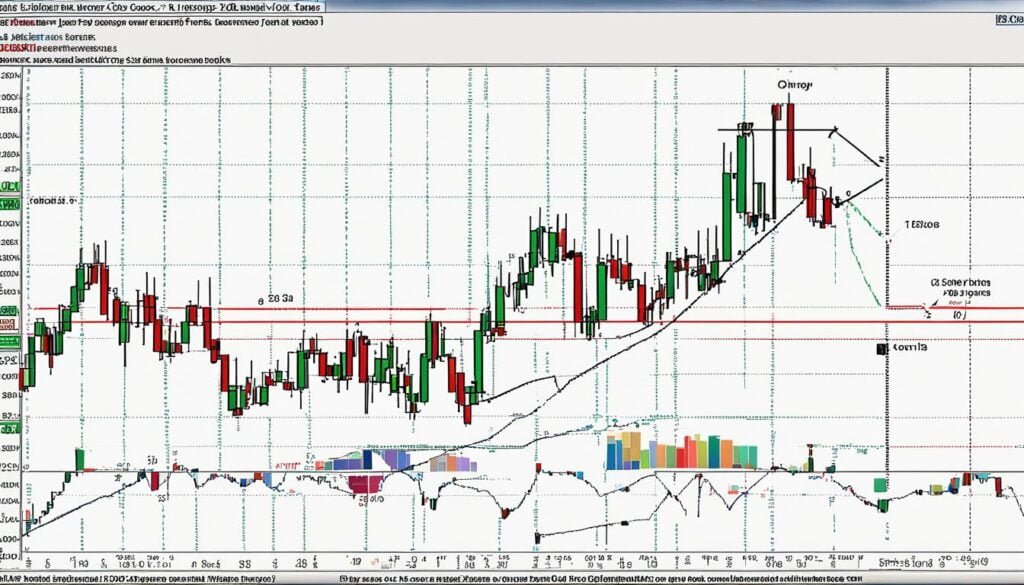
Support and Resistance Levels
Support and resistance levels are significant price levels that indicate potential trend reversals. Resistance levels are price levels that prevent an asset from rising further, while support levels are price levels that prevent an asset from falling further. Understanding support and resistance levels is crucial in identifying trend reversals and making informed trading decisions.
Traders often use moving averages and trendlines to identify support and resistance levels. Moving averages are calculated by averaging price data for a specific period, while trendlines are lines that connect two or more price points on a chart. Identifying and utilizing support and resistance levels can provide valuable insights into market trends.
Trend Analysis Table Example
| Price Pattern Type | Description |
|---|---|
| Head and Shoulders | A reversal pattern that indicates a bearish trend is likely to follow a bullish trend. |
| Double Top/Bottom | A reversal pattern that indicates a bullish trend may be coming to an end. |
| Flag | A continuation pattern that indicates a pause in the trend before it continues in the same direction. |
| Triangle | A continuation pattern that shows a narrowing range of prices and a potential breakout in a specific direction. |
“In summary, price patterns and support and resistance levels are fundamental concepts of trend analysis. Identifying and recognizing these patterns can provide valuable insights into market trends and aid in making successful trades.”
Analyzing Moving Averages
In technical analysis, moving averages are an essential tool for trend identification and analysis. A moving average is a calculation of the average price of a currency pair over a specified period. Traders use moving averages to identify trends and help anticipate potential trend reversals.
There are various types of moving averages, including simple moving averages (SMA) and exponential moving averages (EMA). (Add emphasis: Moving Averages) Simple moving averages provide a straightforward calculation, while exponential moving averages give higher weighting to more recent price data.
Moving averages can help traders identify support and resistance levels, along with confirming trends. For example, if the current price of a currency pair trades above a moving average, it could signify a long-term uptrend. However, if the price falls below the moving average, it could indicate a potential downtrend.
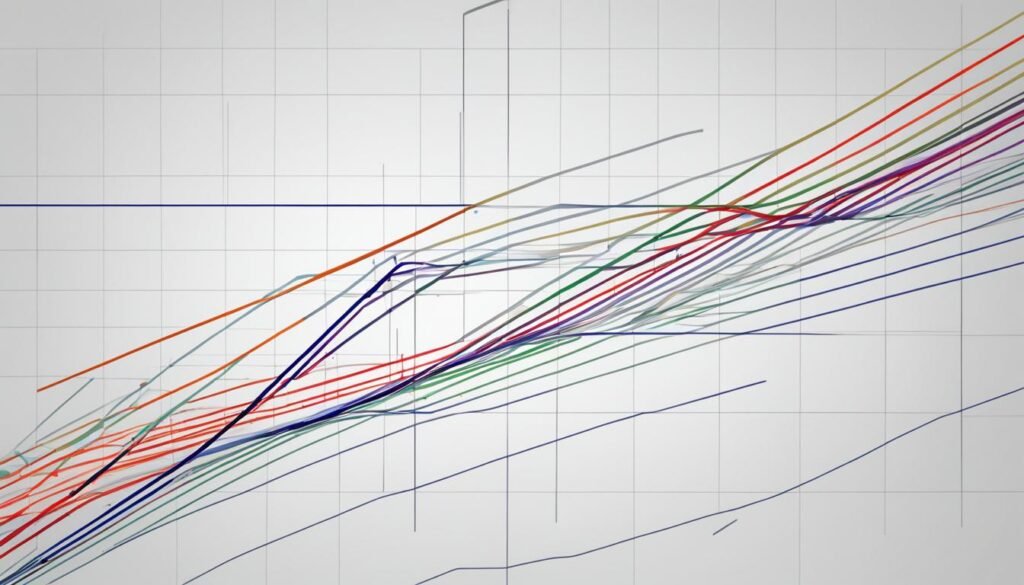
How to Utilize Moving Averages?
To best utilize moving averages, traders commonly employ various moving average strategies. Two popular strategies are the moving average crossover and the multiple moving average technique. The moving average crossover strategy involves using two moving averages, one with a shorter time period and one with a longer time period. When the short-term moving average crosses above the long-term moving average, it signals a potential uptrend, while a cross below suggests a potential downtrend.
The multiple moving average technique involves plotting multiple moving averages with different time periods on a chart. Traders can monitor when the moving averages converge or diverge to identify potential trend reversals or confirmations.
In conclusion, moving averages are a powerful technical analysis tool in trend analysis. By understanding the different types of moving averages and implementing various strategies, traders can gain valuable insight into market trends and make informed trading decisions.
Fibonacci Retracement in Trend Analysis
As we continue exploring the significance of trend analysis, we cannot fail to mention the concept of Fibonacci retracement. Fibonacci levels refer to horizontal lines indicating areas of potential support or resistance within a price trend that can help traders identify optimal entry and exit points. Fibonacci retracement is based on the idea that markets experience pullbacks after significant price moves and that these pullbacks can often be predicted using the Fibonacci ratios. By applying Fibonacci retracement levels, traders can identify price points where a trend may pause and potentially reverse, giving them an edge in the market.
To apply Fibonacci retracement in trend analysis, traders will need to identify the peak and trough of the trend and draw horizontal lines indicating the key Fibonacci levels: 23.6%, 38.2%, 50%, 61.8%, and 100%. These levels will then provide areas of potential support or resistance where traders can watch for trend continuation or reversal.
Overall, Fibonacci retracement is a valuable tool in trend analysis, and by mastering its usage, traders can gain a significant advantage in the currency markets.
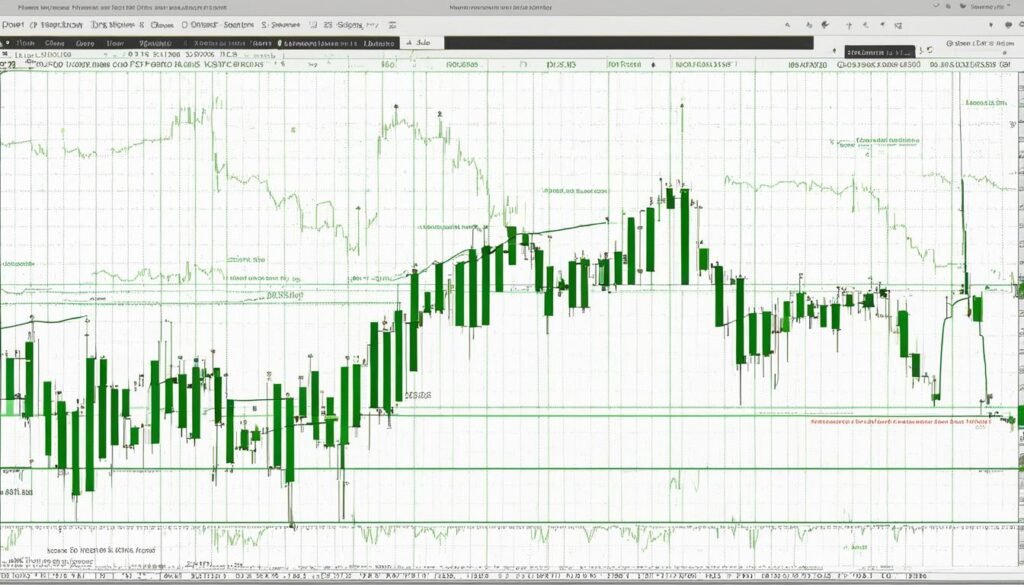
Candlestick Patterns and Trend Analysis
When it comes to identifying trends in the currency markets, candlestick patterns can be a valuable tool for technical analysis beginners. Candlestick charts display price movements using colored candlesticks and help traders recognize patterns that indicate a potential trend reversal or continuation.
Popular candlestick patterns include:
- Harami: a two-candle pattern where a small candle follows a larger one, indicating indecision in the market.
- Doji: a candle with a small body and long shadows on either side, suggesting a possible market reversal.
- Engulfing: a two-candle pattern where one candle completely engulfs the previous one, signaling a possible trend reversal.
By recognizing these patterns and their significance, traders can gain valuable insights into potential trade opportunities and adjust their strategies accordingly.
In addition to candlestick patterns, traders can use technical indicators such as moving averages and Fibonacci retracement to confirm trend analysis and optimize their trading decisions.
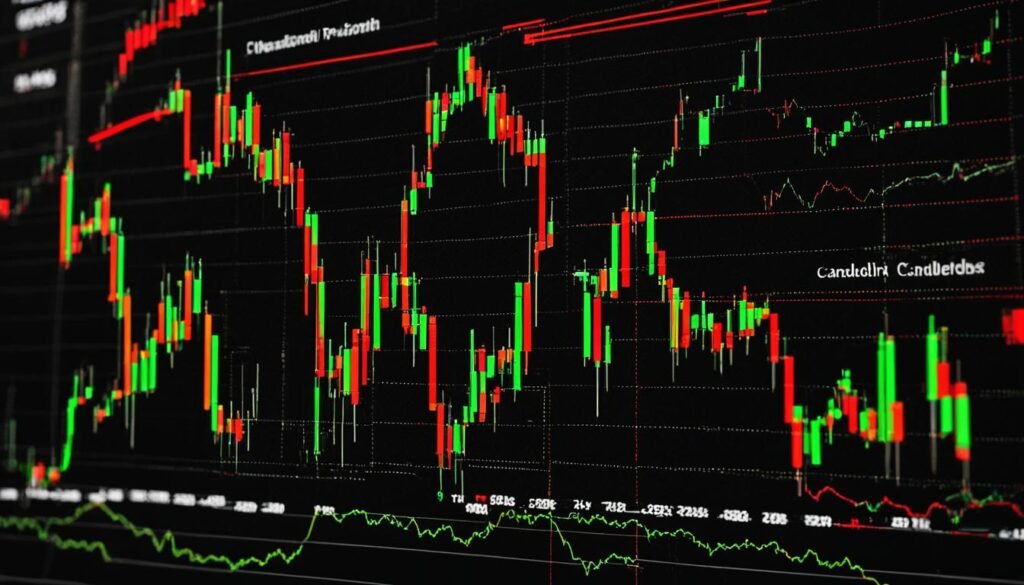
“Candlestick patterns can provide valuable insights into potential trade opportunities and adjust their strategies accordingly.”
Applying Chart Analysis for Trend Identification
Chart analysis is a fundamental tool used in technical analysis, which requires an understanding of various chart patterns that can aid in trend identification. The ability to interpret and analyze charts is a crucial skill for beginners looking to make informed trading decisions.
One of the key benefits of chart analysis is that it helps identify trends by spotting price patterns over time. By studying charts, traders can identify support and resistance levels, pivot points, and trendlines.
One popular chart pattern is the Head and Shoulders pattern, which is considered a reliable indicator of trend reversal. This pattern can be identified by a peak (the head) surrounded by two smaller peaks (the shoulders) on either side. Traders can use a break of the neckline (a line drawn through the bottom of the two shoulders) to confirm the downtrend.
Candlestick Charts
Candlestick charts are another type of chart used in technical analysis to identify trends. This type of chart is named for its candlestick-shaped data markers, which display the price range and opening and closing prices for a set period.
Candlestick patterns on charts can provide valuable insights into trend reversal or continuation. For example, a Bullish Engulfing candlestick pattern occurs when a small bearish candlestick is followed by a larger bullish candlestick. This pattern could indicate a trend reversal, making it a strong buy signal for traders.
Combining Technical Indicators for Trend Confirmation
Technical analysis is an essential tool for traders to make informed decisions in the currency markets. One crucial part of technical analysis is trend confirmation, which involves using technical indicators to validate market trends. By combining different technical indicators, traders can generate more accurate signals, which can improve their decision-making ability.
There are several techniques to combine technical indicators for trend confirmation. One is to use a moving average crossover strategy, where traders use two moving averages of different periods and wait for the crossover of the two lines. This strategy can help identify trend reversals and confirm the strength of the trend.
Another technique is to use oscillators, which are indicators that measure the momentum of price movements. By combining different oscillators, traders can generate more reliable signals and improve their chances of making profitable trades.
“Combining technical indicators can help improve the accuracy of trend analysis, which is crucial to make profitable trading decisions in the currency markets.”
Traders should ensure that the technical indicators used for trend confirmation are relevant to the currency pair being analyzed. For example, some technical indicators may work better for volatile currency pairs, while others may work better for stable currency pairs.
Furthermore, it is important to avoid overcomplicating the use of technical indicators. Traders should strive to use only a few indicators that complement each other and avoid using too many indicators that may contradict each other, leading to confusion and inaccurate signals.
To summarize, combining technical indicators is a powerful technique for trend confirmation in technical analysis. By carefully selecting and using relevant technical indicators, traders can improve their chances of making informed trading decisions and achieving profitability in the currency markets.
Case Studies: Realizing Trends in Currency Markets
In the previous sections, we’ve covered the fundamental concepts of trend analysis, technical indicators, and chart analysis. In this section, we’ll demonstrate how trend analysis can be applied in real-world scenarios through case studies in the currency markets.
Case Study 1: The USD/JPY currency pair
| Date | Exchange Rate | Trend Analysis |
|---|---|---|
| January 1, 2021 | 103.50 | The price is in a downtrend, with several lower highs and lower lows over the past few months. |
| April 1, 2021 | 109.50 | The price has broken above the previous resistance level and is now in an uptrend. |
| July 1, 2021 | 111.50 | The price has continued to trend upwards, with higher highs and higher lows. |
By analyzing the trend in the USD/JPY currency pair, traders could have predicted a potential uptrend and made profitable trading decisions accordingly.
Case Study 2: The EUR/USD currency pair
| Date | Exchange Rate | Trend Analysis |
|---|---|---|
| January 1, 2021 | 1.2200 | The price is in an uptrend, with several higher highs and higher lows over the past few months. |
| April 1, 2021 | 1.1900 | The price has broken below the previous support level and is now in a downtrend. |
| July 1, 2021 | 1.1800 | The price has continued to trend downwards, with lower highs and lower lows. |
By using trend analysis on the EUR/USD currency pair, traders could have predicted a potential downtrend and made profitable trading decisions accordingly.
Through these case studies, we have seen how trend analysis can be used effectively in the currency markets to make informed trading decisions. By applying the concepts covered in this article, aspiring traders can gain valuable insights into analyzing trends and developing profitable trading strategies.
Implementing Trend Analysis in Your Trading Strategy
Now that you have a good understanding of trend analysis in technical analysis, it’s time to incorporate this knowledge into your overall trading strategy. By doing so, you can enhance your chances of making informed trading decisions and minimizing risks.
The first step is to identify the timeframe that suits your trading style and goals. For instance, if you prefer a shorter-term approach, you may focus on trends in the daily charts. On the other hand, if you have a longer investment horizon, weekly or monthly charts could provide more comprehensive and robust trend analysis.
Using different chart timeframes is important in confirming trends and determining potential entry and exit points. You can use moving averages and other technical indicators to complement trend analysis and improve accuracy.
It’s also important to have a clear understanding of the risk management strategy that you will use when trading. Managing your risks effectively can help you avoid significant losses, while maximizing returns.
Here are some practical tips for incorporating trend analysis into your trading strategy:
- Scan through multiple currency pairs to identify potential trends and trading opportunities
- Use stop-loss orders to manage risk effectively
- Stay up to date with economic news and events that may impact currency markets
- Take a break from trading when you feel burnt out or overwhelmed
By implementing trend analysis into your trading strategy, you can gain valuable insights into the currency markets and make informed trading decisions. Remember, it’s essential to keep learning and adapting your strategy based on changing market conditions and trends.
Conclusion
As highlighted in this article, trend analysis is a crucial tool for technical analysis beginners aiming to navigate the currency markets. With an understanding of market trends and fundamental concepts of trend analysis, traders can make informed trading decisions that lead to profitability.
By incorporating technical indicators, moving averages, Fibonacci retracement, candlestick patterns, and chart analysis, traders can enhance their trend analysis accuracy. Real-world case studies are evidence of how trend analysis can be used effectively for profitable trading decisions in the currency markets.
As such, beginners must implement trend analysis as part of their overall trading strategy to achieve long-term success. With ongoing education and practice, traders can attain mastery of trend analysis and make informed trading decisions based on market trends.
FAQ
What is technical analysis?
Technical analysis is a method of analyzing financial markets by studying historical price and volume data. It focuses on using various technical indicators, price patterns, and chart analysis to predict future price movements.
Why is trend analysis important in technical analysis?
Trend analysis is crucial in technical analysis as it helps traders identify the direction of the market. By understanding market trends, traders can make informed trading decisions and capitalize on potential opportunities.
What are some common technical indicators used in trend analysis?
Some common technical indicators used in trend analysis include moving averages, Fibonacci retracement levels, and various oscillators such as the Relative Strength Index (RSI) and Moving Average Convergence Divergence (MACD).
What are price patterns in trend analysis?
Price patterns are recurring formations on price charts that provide insights into market trends. Examples of price patterns include triangles, head and shoulders, and double tops/bottoms. Traders use these patterns to anticipate trend continuation or potential reversals.
How do support and resistance levels influence trend analysis?
Support and resistance levels are price levels where buying (support) or selling (resistance) pressure is expected to be significant. These levels help traders identify potential reversal points or areas where trends are likely to continue.
How can moving averages help in trend analysis?
Moving averages are widely used in trend analysis to smoothen out price data and identify the overall direction of the trend. The crossover of different moving averages can signal trend reversals or confirm the strength of an existing trend.
What is Fibonacci retracement in trend analysis?
Fibonacci retracement is a tool used to identify potential support or resistance levels based on key Fibonacci ratios. Traders use these levels to determine areas of potential trend continuation after a retracement.
What are candlestick patterns and how do they relate to trend analysis?
Candlestick patterns are graphical representations of price movements on a chart. These patterns provide valuable insights into trend reversal or continuation. Examples of candlestick patterns include doji, hammer, and engulfing patterns.
How does chart analysis aid in trend identification?
Chart analysis involves studying different chart patterns, such as triangles, wedges, and flags, to identify trends. By recognizing these patterns, traders can gain a better understanding of the market’s direction and make informed trading decisions.
How can multiple technical indicators be combined to confirm trends?
Traders often combine multiple technical indicators, such as moving averages, oscillators, and trendlines, to confirm trends. Convergence of signals from different indicators can provide stronger confirmation of a trend.
How can trend analysis be applied in real-world trading scenarios?
Real-world case studies demonstrate how trend analysis can be used effectively in the currency markets. By analyzing these scenarios, traders can gain insights into practical applications of trend analysis and its impact on trading decisions.
How can beginners implement trend analysis in their trading strategy?
Beginners can incorporate trend analysis into their trading strategy by studying market trends, using technical indicators, and applying chart analysis techniques. It is essential to combine trend analysis with risk management and other fundamental analysis methods.
Why is trend analysis an essential aspect of technical analysis?
Trend analysis provides traders with valuable insights into market direction and potential trading opportunities. By understanding trends, traders can make informed decisions, manage risk effectively, and increase their chances of success in the currency markets.
